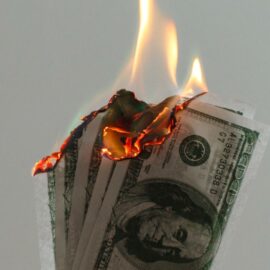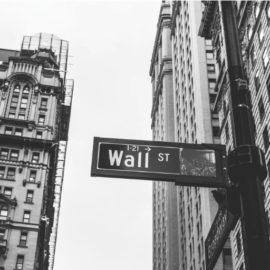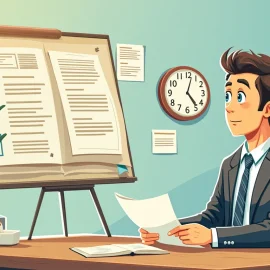

This article is an excerpt from the Shortform summary of "The Smartest Guys in the Room" by Bethany McLean and Peter Elkind. Shortform has the world's best summaries of books you should be reading.
Like this article? Sign up for a free trial here .
Are you looking for a great Enron case analysis to help you understand one of the biggest business scandals of all time?
This Enron case analysis offers a background on Enron’s business, and a detailed account of its decline. In this Enron case analysis, you’ll find details about Enron’s stock history as well as the reasons it finally failed.
Enron Case Analysis Background
The failure of Enron in the early 2000’s is one of the largest bankruptcies in US history (with Lehman Brothers in 2008 as the largest). Its accounting scandal led to Enron’s bankruptcy as well as the dissolution of Arthur Andersen, one of the big five accounting firms. Shareholders were wiped out, and tens of thousands of employees left with worthless retirement accounts.
Today the name “Enron” still evokes a reflexive repulsion, a feeling that these were simply bad people doing illegal things. But, we think, that’s in the past. Surely we’ve evolved as a society, and by thinking hard enough, you or I can avoid these problems.
These are also the warning signs you can use to detect unstable situations and desist from bad behavior. This Enron case summary reviews how and why Enron failed.
Enron’s Stock Price Rockets
Despite all this trouble bubbling under the surface, in the heady period of 1999-2000, Enron stock exploded in price, reaching ~90 in Aug 1999 before being split 2:1, then doubling to reach 90 again in Aug 2000 for a market cap of $70 billion. It outperformed the S&P by over 200%.
This is a testament to how powerfully its accounting distortions disguised the true nature of the problems brewing.
Enron Case Analysis: Beginning of the End
The next part of the Enron Case Analysis is its fall. Despite Enron’s best efforts to conceal their losses, by late 2000, skepticism started mounting. The dotcom bubble had fallen from its peak, and company fundamentals were being questioned.
On December 2000, Jeff Skilling was announced to succeed Ken Lay as CEO, taking place in February. This was already planned well in advance – his contract had a trigger – if he weren’t named CEO by end of 2000, he could leave and be paid over $20MM.
Concerns Mount
There started to be mounting external and internal concern about the reality of the losses.
By spring 2000, the dotcom bull market was over. Analysts were now questioning business plans and looking for fundamental cashflow and revenue. Momentum investors were selling instead of buying.
- Stories ran about how energy companies used mark-to-market accounting, and no outsider knew the assumptions they used to book earnings.
- Short sellers were gaining credibility and wielding larger sticks. Investor Chanos was skeptical Enron’s broadband business could be doing so well when the rest of the industry was getting slaughtered.
More negative signs cast doubt on Enron:
- Unclear disclosures about dealings with a related party
- Lay and Skilling were selling shares
- Debt was climbing when Enron was supposed to be profitable
- No one could explain how Enron made money
- Redeployments/layoffs were happening at the broadband business.
- In April 2001, on an earnings call, Skilling famously called a skeptical short-seller an “asshole” for saying Enron was the only firm who couldn’t release a balance sheet or cashflow statement. Said a stunned analyst, “any CEO should be able to handle the hardest of questions from the most aggressive of shorts.”
In February 2001, an Enron accountant, Wanda Curry, saw that EES (the retail division) had over-optimistic valuations of deals and bad trades that, on inspection, actually put the division in the red by $500MM.
- Enron’s solution was to merge the trading losses with the wholesale traders’ profits, eking out a mild profit in total. However, Enron didn’t properly report the combination of the two.
In March 2001, this book’s author (Bethany McLean) published a landmark article, “Is Enron Overpriced”, which showed the public that professional analysts had no idea how Enron made money.
In May 2001, a researcher wrote a paper deconstructing Enron’s cash flow. Of Enron’s reported $4.8 billion in operating cash flow, $2 billion was from customer deposits (which would be paid back if energy prices fell); $1 billion was from a onetime sale of inventory, and another $1.5 billion was the result of prepay. This showed a dramatically different story than the idea that Enron’s cash flow was stable and recurring.
The Dominoes Start to Fall
As a result, Enron’s stock price fell dramatically: from a height of $82 after their investor conference in Jan 2001, down to $68.50 in Feb 28 and $55 in March 21.
- Even in July 2001, when Skilling announced Enron had beaten earnings per share, share prices didn’t budge. The market had become too skeptical.
In August 2001, Skilling resigned as CEO.
- Reasons: The pressures of maintaining a rosy public facade while dealing with internal turmoil ate at him. For someone obsessed with the stock price, its decline represented a personal failure. He hated getting his hands dirty, and his job was now about fixing problems.
- Skilling’s resignation fueled suspicion that something was wrong inside Enron.
Here was the nightmare dominoes scenario – where all the intricately connected layers would fail because of their dependencies:
- If Enron missed earnings, its stock price would fall.
- If its stock fell, its SPE deals would unwind (since they were predicated on Enron stock prices rising), causing Enron to have to book massive debt on its balance sheet or issue new shares. This would cause further stock price falls.
- This increased debt would cause a downgrade of Enron’s creditworthiness.
- This would trigger provisions in Enron’s debt agreements to pay back loans early, and trading partners to demand cash collateral.
- Since Enron didn’t actually have cash, its ability to pay would progressively worsen, causing it to go bankrupt.
- Senior managers predicted the likelihood of this at less than 25%.
Enron Case Analysis: Enron’s Final Moments
Finally, you can see in the Enron Case analysis that the worse case scenario happened. The nightmare scenario is more or less what happened at the end of 2001. Over a series of months, Enron collapsed, one step after another.
Internal rumors began circulating about issues at Enron.
- Accountants looking into the SPE deals realized that the falling value of assets in the SPEs, along with the falling Enron stock price, were going to become difficult to pay off. “It’s a bit like robbing the bank in one year and trying to pay it back 2 years later.”
- It was known that EES’s losses were being hidden in wholesale. In an employee letter: “This is common knowledge…and is actually joked about.”
The SPE Raptor deals ran into trouble.
- The Raptor deals became underwater by 9 figures, especially in the market hit after September 11.
- Andersen auditors realized they made an accounting error – Raptor restructuring had been booked as a boost in shareholder equity and needed to be reversed, costing equity $1.2 billion.
- This would be recorded as a simple equity reduction, rather than a restatement, which would admit mistakes and trigger SEC inquiries and lawsuits.
- COO Whalley argued to take the hit and clean up. They felt Enron would recover after cleaning up.
- To make the accounting look more favorable, Enron wanted the correction as a nonrecurring charge. Since this was originally booked as operating profit, this was grossly inappropriate. Andersen put up a fight, but ultimately Enron forced their hand.
On Oct 16 2001, Enron shared its third quarter report. They were sanguine as usual: “recurring Q3 earnings of $.03 per diluted share; reports nonrecurring charges of $1.01 billion…reaffirms recurring estimates.
On Oct 24, 2001, Enron was unable to roll its “commercial paper,” short-term loans used for day-to-day expenses. It had no operating cash.
- It desperately tried to make deals for cash – like opening up its books – but no one was willing to bite. It had to draw down $3 billion in backup credit lines.
- The last-ditch solution was to sell their pipelines, the only steady cash generator Enron had left.
- Enron’s trading also required credit to survive – trading partners would start demanding cash collateral.
Through this turmoil, Arthur Andersen began realizing how bad their work with Enron would make them look.
- Andersen had previously paid fines for accounting fraud at Waste Management – it had a cease-and-desist from the SEC from misconduct. In that case, Andersen’s records had provided regulators with plenty of proof – it wanted to avoid that mistake again.
- There was a shredding frenzy in both Enron and Arthur Andersen (following normal “document retention procedures”) until an official subpoena on Oct 26 forced them to stop.
- Andersen also saw major mistakes in Enron’s SPEs accounting, with the 3% not being truly independent capital. This meant the deals had to go back on Enron’s books.
Once dancing to Enron’s tune, the bankers realized their new leverage over Enron and took advantage.
- Beyond its credit line, Enron needed an extra $2 billion in cash. Banks refused to let it borrow the loans unsecured like before – now it demanded the only collateral remaining – the pipeline systems – and exclusive business with Enron for the next 18 months.
In early November, a possible savior came in a possible merger with smaller energy company Dynegy.
- For years, Enron took pot shots at Dynegy for being a tiny wannabe and threatened to steamroll it in every business line. The Dynegy CEO now saw a chance to get even, inherit its valuable trading operations, and vault his company to leading position in energy trading.
- The structure – Dynegy would buy Enron at market price. ChevronTexaco (26% owner of Dynegy) would provide $2.5 billion ($1.5 billion now, $1 on closing).
- In reality, this was undercapitalized from the start – Enron assumed that having ChevronTexaco onboard would be so reassuring its capital needs would shrink.
- Dynegy estimated it would boost earnings per share by 35%, with over $200 billion in revenue and over $90 billion in assets.
- The traders weren’t happy about this deal. They had already felt they were carrying Enron, and now they felt small dumb Dynegy was unworthy of buying Enron. The traders banded together to demand bonuses in cash upfront, or they’d blow up the deal.
Meanwhile, the SEC required that Enron disclose the Fastow partnerships and restate its earnings on Thursday November 8.
- Also, all three ratings agencies cut Enron to one notch above junk by Nov 5. Shares went below $10.
- On Wednesday, the stock dropped 25% on news that Enron was unable to line up $2 billion from private investors.
On Friday, Enron announced the merger with Dynegy. Shares rose 16% to $10.
On Tuesday, November 13, $2 billion arrived for Enron. They took a breath, but it wasn’t enough.
- Enron realized it was going to need to repay more than $9 billion by the end of 2002. It would need a lot more money.
- Enron’s trading partners continued demanding collateral. The number of transactions plummeted, and trading profits crashed.
- An SPE (Rawhide) was structured to unwind if its debt had been downgraded to one step above junk. It now had to repay $690 million in debt.
- In six days, Enron had burned through a billion dollars. Its stock fell to below $5.
On Dynegy’s side, the lack of transparent disclosure of possible problems and Ken Lay’s insistence on maintaining control of Enron crashed the deal. The banks weren’t coming up with more money that Enron needed.
On Wednesday November 28, the rating agencies cut Enron into junk territory. This triggers the end of the Enron case summary.
- This triggered $3.9 billion in debt.
- Dynegy officially canceled the deal.
- Enron Online shut down. Shares dropped to $0.61
Banks moved to minimize their losses, asking for return of collateral. Enron didn’t have it.
On Sunday, December 2, Enron filed for bankruptcy.
Hopefully in this Enron case analysis you’ve learned the financial reasons that Enron eventually failed. Keep in mind that this Enron case analysis spent less time on other reasons like a deceptive work culture.

———End of Preview———
Like what you just read? Read the rest of the world's best summary of Bethany McLean and Peter Elkind's "The Smartest Guys in the Room" at Shortform .
Here's what you'll find in our full The Smartest Guys in the Room summary :
- How Enron rose to become one of the world's most promising companies
- How Enron management's greed led it to start cutting corners
- The critical failures that crashed Enron's house of cards to the ground






